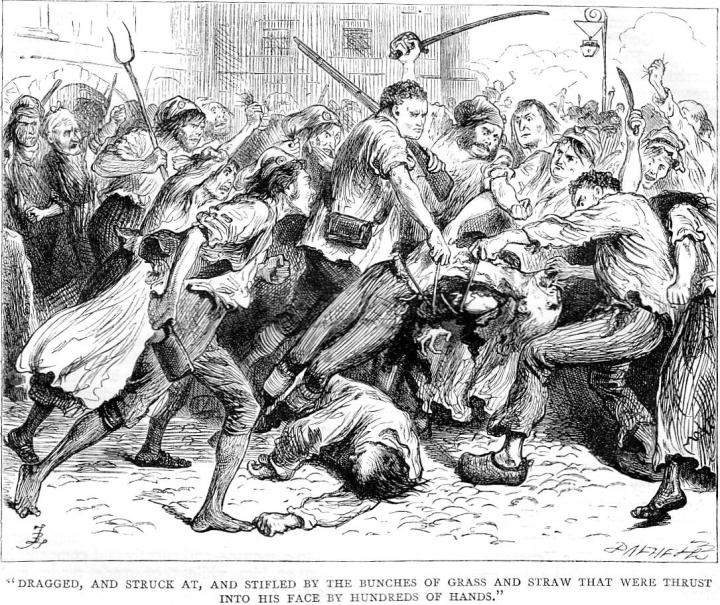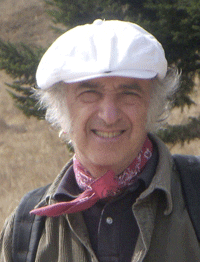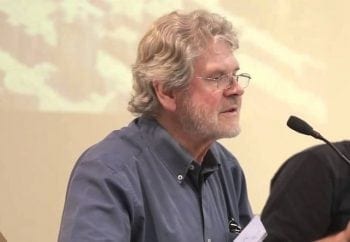RULING CLASS FEARS OF THE DAY OF RECKONING: HISTORICAL CAUSES FOR THE BIASES AGAINST CROWDS
Purpose of this article
The purpose of this article is to:
- Expose the propagandist roots and branches of our biases against crowds while showing some of the scientific evidence that supports the actual behavior of crowds.
- To outline what historical events occurred that supported the prejudice against crowds.
- Propose that it is ruling-class fears of crowds that fuels the perpetuation of unscientific theories about crowds.
- Propose that ruling class fears that working-class people mobilized into crowds will seize their resources, destroy their property and enslave them.
Crowds vs Masses
Crowds are large collections of people who meet at the same place at the same time and are large enough that it is difficult to have a central conversation. A loudspeaker, microphone or some external device is necessary to have a single central discussion. There are different kinds of crowds. There are casual crowds like those that meet by chance at the scene of an accident or a fire. They may congregate to watch a building go up or be torn down. A second kind of crowd is long lines that form to buy tickets to ball games or musical concerts.
An audience is a more formal crowd with a more deliberate focus. Examples are attending a musical concert or a sporting event. Lastly, there are unconventional crowds that can lead to riots, lynchings, protests and demonstrations. Mass behavior involves large numbers of people who are spatially dispersed but participate in common activities like fads or fashions. Mass behavior involves the use of radio (Orson Wells, War of the Worlds) television, movies which often lead to rumors or urban legends.
Questionnaire on Crowds
In order to understand the purposes of this article, I ask that you spend about 25 to 30 minutes answering the following true-false questions. For the answer to be true, it simply means most of the time, not all the time. For the answer to be false, it just means it rarely happens, not never happens. Follow your answer with a one-sentence justification. Feel free to draw from your experience as well as what you’ve read. It is important to answer quickly and spontaneously and not dwell on the answers. One purpose of the questionnaire is to see if you think there are any significant differences between how people in crowds behave (collective behavior) as opposed to how small groups or individuals behave.
Here are the True – False questions:
- Most crowds consist of strangers, rather than family, friends or acquaintances.
- The percentage of violent behavior is higher in crowds than in small groups such as a musical band or a baseball team.
- The behavior of crowds is more likely to be unanimous than the behavior of small groups.
- Crowds of people are more likely to engage in unusual or extraordinary behaviors than either groups or individuals.
- The behavior of individuals and small groups is more likely to be rational than the behavior of a crowd, which is more likely to be
- There are certain kinds of personalities that are drawn to crowds that you could predict would join a crowd if you knew enough about their personalities.
- There is a disproportionately higher number of working-class people in crowds compared to other social classes.
- Compared to people without legal convictions, there is a higher percentage of criminals in crowds.
- Individuals and small groups that are more likely to deliberate and plan their actions are less likely to be spontaneous.
- You could predict that most individuals are more likely to lose their personal identity in a crowd rather than alone or in small groups.
- Emotions are more likely to spread by contagions in a crowd rather than in a small group.
- Groups are easier to disperse than crowds because people in crowds want to linger longer.
- There has been more research done on crowds than on groups because the behavior in crowds has greater social impact.
- People conform less to norms in crowds than they do in groups or as individuals.
- Most violence in crowds is caused by the participants in the crowd rather than the police.
- There is a higher degree of unpredictability of behavior in crowds than there is in small groups or within an individual.
- The goals of a crowd are more extreme and unconventional than the goals of groups or individuals.
- Riots are equally likely to happen regardless of the season of the year.
- The most typical reaction to a natural disaster or emotional shock is panic – that is, uncontrolled individualistic flight as opposed to a rational, deliberate response.
- There is a correlation between which people will engage in a protest and their political beliefs before the protests.
- The most likely group to join a movement is the group who has absolute deprivation of resources as opposed to relative deprivation or no deprivation.
The last three questions are about mass behavior, not crowd behavior:
- Fads are less predictable than fashions.
- Rumors begin mostly because people lose their ability to investigate before coming to a conclusion.
- Fashions exist in all societies – tribal and industrial – as well as industrial.
Myths vs Facts About Crowds
In their book, Social Psychology, Delamater Myers and Collett, citing the research of Carl Couch, Clark McPhail, David Schweingruber and Ronald Wohlstein argued that there are seven basic myths about crowds. They are:
- Irrationality
- Emotionality
- Suggestibility – mindless behavior
- Destructiveness
- Spontaneity
- Anonymity
- Unanimity of purpose
Through these seven myths we are likely to see why all the answers in relation to crowds to the True-False questions are false. The only true answers are the first two questions about masses. Rather than explaining why every single question on crowds are false, I will speak generally and then answer a few questions specifically.
Are crowds wholes that are less than the sum of their parts?
One of the great underlying beliefs about crowds is that terrible things happen in a crowd that somehow would not happen in a small group and especially at an individual level. Individuals are seen as rational, non-violent and prudent, but once the individual is surrounded by enough other individuals, things turn sour. The belief is that while individuals and groups may have differences with each other, those differences melt away in a crowd as individual members turn into a group hive. In fact, differences between individuals and small groups are maintained in crowds. To cite one example, in riots, crowds rarely act in unison. Some throw rocks and break windows. Others climb telephone poles and smash statues. Others disapprove and try to talk the others out of armed conflict. Still others are altruistic and help protesters who have been injured by cops.
Who is orderly and disorderly in crowds?
Speaking of cops, research on mass psychology has shown that most of the time, contrary to Le Bon, riots are started by the police, not the crowd. Furthermore, crowds assemble and disassemble at ballgames and concerts without any police necessary. Once gathered crowds do not stick together like honey. They easily disperse and really do not need the police to do so. I have been to many a Yankee and Knicks game in which the crowd, anywhere from 15 thousand to 30 thousand people leave the game, peacefully get on the train and talk about the ballgame. There is no need for police because nothing controversial happens. For conservatives like Le Bon, they cannot imagine that crowds regulate themselves. For them crowds are filled with animalistic, hedonistic barbarians who need the police to whip them into order.
Are working-class people more likely to be disorderly?
There is some truth to the fact that a higher percentage of working-class people will be in crowds. This has more to do with the reality that middle-class or upper-middle class people can afford to take a taxi to a ball game or a concert instead of taking the train. But this has little to do with the behavior of working-class crowds. Furthermore, plenty of protests are filled with upper-middle class anarchists who torch police cars and topple monuments. There is no clear relationship between social class and crowd violence.
How unpredictable are crowds?
Another one of Le Bon’s mistaken generalizations about crowds is that people in crowds act without rhyme or reason. This demonstrates, as an upper middle-class doctor, Le Bon has no understanding of all the deliberation and planning that goes into protests on the part of the organizers. This planning goes on weeks before the event. It is true that unpredictable things happen in protects, but they are exceptions to the rule. Furthermore, individuals act in unpredictable ways, as in the case of mass shootings. Individuals get caught up in cults and act in unpredictable and astonishing ways. Cults are large groups, not crowds.
Are emotions in crowds contagious?

The idea of violent, irrational, and out-of-control crowds, was perpetuated by conservative observers of the great social tumult they saw in the French Revolution. People like Burke and Dickens did not understand the dynamics of such upheavals, the valid reasons for group action, and therefore focused only on the uglier side of such events, often caricaturing the protagonists and their motives.
People are every bit as emotional in small groups as they are in crowds. There is nothing contagious about emotions in crowds. People maintain emotional judgment while in the crowd. In fact, the leaders of protests harangue people to sing and chant as a way to unify the group. Just being in a crowd does not automatically unify the individuals. It takes work to do so. When faced with members of a crowd who become hysterical, rather than mindlessly joining in, other members of the crowd will distance themselves and exercise the same prudence that individuals or people in small groups will.
Is the crowd to social life what Freud’s id is to individual life?
Le Bon, Freud, Bion and the rest of the crowd psychologist we will soon meet think that at the social level the crowd is like the id, lurking on the margins of society waiting for a chance to jump out and wreak havoc. This is exemplified in the movie Lord of the Flies, by William Golding. In natural disasters these crowd psychologists imagine that the socialized ego is swarmed by the individualistic dictum, “every person for himself”. They imagine the results are pillaging and raping. The trouble is that research on behavior in natural disasters shows that people are consistently heroic and cooperative.
One hundred years of neglect of scientific research on crowds
Lastly, unlike individual psychology and group psychology the scientific study of crowds and masses lags way behind. It wasn’t until the late 1960s that the first research was done. Why is this? On the one hand, studying crowds is far more difficult because crowds are so large and their life-times short. But something else was going on. Why were Le Bon’s, Tarde’s and Sighele’s, speculations allowed to stand unchallenged and repeated mindlessly in social psychology textbooks for almost 100 years? In large part it was because their theories served the interests of the ruling class.
Historical Reasons for the Biases Against Crowds
Growth of cities
One of major changes in European history and geography was the gradual reversal of numbers of people living in cities compared to those of people living on farms. People move to cities in part because there is more work, but also, as the saying goes, “city air makes you free”. Some people felt trapped by the nosiness and stifling customs of rural life. Non-conformists to religious traditions, artists and hustlers with big dreams were drawn to cities for a chance to start fresh. Living on a farm, the general expectations was that you would engage in the same occupation as your parents. Moving to the city broke that tradition and it raised expectations. Especially those living in coastal cities who were exposed not only to people coming from different cities within Yankeedom, but people from other countries were also looking for work. Different languages, different religions, and different political traditions converged.
There are rarely, if ever, crowds in rural areas. While farmers may get together on holidays, everyone knows everyone else and rarely are strangers invited. Even when farmers would go to town to get supplies, the overwhelming number of people knew each other and greeted each other. There were no stadiums or concert halls in which large numbers of people could congregate to watch professional sports or music. Long before the Industrial Revolution, crowds in cities would gather to hear political speeches. So, what we have in pre-industrial cities are relatively rootless people with raised expectations, surrounded by strangers from different cultures for whom being in a crowd is becoming normal.
The Great French revolutions
As most of you know, the French Revolution of 1789 overthrew both the king and the aristocrats as the merchants rose to power on the backs of artisans and peasants. The revolution was also anti-clerical. Churches and chateaux were burned to the ground. The aristocrats never forgot this. As if your memory needed any jogging, there were more revolutions in Paris in 1830 and 1848. In all these revolutions, crowds are violent and know where the upper classes live. Doesn’t it start to make sense that the study of crowds would never be objective so long as the upper classes were threatened by them and therefore controlled the research on crowds? In this case they made sure no research was done.
Industrialization
At the end of the 18th century and throughout the 19th century, cities became industrialized. People were forced off the middle of streets to make way for wheeled vehicles accompanied by horses and later, trolley cars. Grid systems of streets were built which speeded up transportation and the circulation of goods. Industrial capitalists built factories in cities as opposed to artisan shops in the countryside (the putting out system). The emergence of factories had enormous revolutionary potential because it brought large numbers of people working under horrible conditions together. For 12-15 hours a day, at least six days a week, people have a common experience while all in the same place and the same time.
Formation of unions
It is no accident that unions first formed in factories. When common experience is concentrated at the same place and same time, people are likely to compare experiences and accumulate grievances. Some workers begin to recognize that they have collective power if they can organize themselves. They can strike for better working conditions and better wages. Unions made crowds more dangerous because crowds can, in an extremely chilling way, stop and start the work process itself. This is like cutting off the blood supply for vampiric capitalists.
Emergence of socialism
The first socialists were theoretical and utopian—they explored idealist conceptions of social transformation. William Godwin was the first theoretical anarchist, writing Enquiry Concerning Political Justice. In the early 19th century, there were utopian communities set up by Robert Owen, Charles Fourier and others but none of these communities were connected to unions or workers movements. It wasn’t until the writings of Marx and Engels that socialism was really connected to worker’s struggles. The socialism of Marx and Engels or the anarchism of Bakunin both said to workers, “it is not enough to have tiny little pieces of pie. You create all the wealth; you deserve the whole pie.”
In order to gain the whole pie, workers in crowds had to move in a mass, take over factories and run them for themselves, while confiscating the private property of the upper classes. For the upper classes, socialism and the prospects of crowds burning down their houses, and peasants taking over their land was their worst nightmare. The Paris Commune of 1871 was the first revolutionary situation that was inspired by socialism as a movement.
Stock Market instabilities
Crowd instabilities also came from the capitalist side, between 1873 to 1896 when the stock market was very unstable creating panics and depressions. [Instability—the dreaded cycle of boom and bust—is actually one of capitalism's intrinsic features. It derives from capitalism's mode of production which creates the absurdity of "overproduction in the midst of plenty."] This meant stock market traders were wheeling and dealing on the floor of the stock market at the same time that people who had money in banks were worried about their savings and, in some cases making runs on the banks.
Crowd Psychologists
Origins of Crowd Theory
Crowd theorists were social Darwinists whose ideas of a liberal society were of individuals who took care of only themselves. Beginning about 1870, crowd psychologists claimed that Darwinian evolution demonstrated that progress was a slow process, and any sudden changes based on violence were throwbacks to premodern times. Crowds were looked upon as akin to Herbert Spencer’s undifferentiated matter.
According to H. Stuart Hughes, (Consciousness and Society), beginning in the 1890s intellectuals became obsessed with the prospect that unconscious, primitive, and emotional forces were driving things. Crowd psychologists were united in rejecting sociological theorists such as Durkheim and Marx because they ignored emotions and unconscious motivation. What was really driving crowds, they thought, was below the level of consciousness. For crowd psychologists, individuals were both more than and less than the sum of their parts. The four major crowd theorists were Hippolyte Taine, Scipio Sighele, Gabriel Tarde, and Gustave Le Bon.
Crowd Theorists
Taine
Taine’s Origins of Contemporary France (written between 1876 and 1894) was a conservative attack on the Enlightenment. Taine blamed the Enlightenment ideas, including Rousseau’s, for what he considered the bloodbath of the French Revolution. Taine believed that the line between normal cognition and hallucinations, dreams and delusions, was closer than we might suspect. He cited evidence from research on organic lesions of the brain, hypnotism, and split personalities. He determined that the dramatic transformation of humans into savages is caused by what he called “the laws of mental contagion.” With the exception of the hypnosis model, Taine’s book embodies all the rudiments of French crowd psychology. For Taine, all leaders were the crazed dregs of society.
According to Taine, the Enlightenment failed to factor in the amount of time it took for humans to develop from barbarity to civility. Enlighteners weren’t interested in how people really were, but only as they could be measured by an abstract, ideal humanity. Taine thought the French Revolution was a relapse into primitive barbarism. Like Hume, Taine thought that reason was the passive servant of the passions. Bodily needs, animal instinct, prejudices which Taine thought were hereditary, were really driving people.
Criminalization of crowds (Sighele)
Theories of hypnosis were split in two directions. Followers of Charcot claimed that being suggestible was a sign of psychopathology and only certain types of people could be hypnotized. The Nancy school of Bergheim argued that anyone could be hypnotized. The criminal school of Sighele sided with Charcot, arguing that crowds were composed of criminal individuals who were naturally suggestible. He followed the work of Lombroso who was a medical scholar of deviants in the military. Lombroso measured the skulls and anatomical characteristics of 3,000 soldiers.
According to Serge Moscovici (The Age of the Crowd), mass psychology was treated simply as part of criminal anthropology. Crowds were seen as mobs, scum, and made up of men who were out of control and would destroy anything in their path. Sighele claimed that hypnotism can explain the process by which individual minds become susceptible to outside forces, leading to actions that that are carried out automatically, unconsciously, and then spread to others by contagion. The conservative hand Sighele played was transparent in his labeling of social revolutionaries such as socialists, anarchists, or even striking workers as part of the criminal crowd. The hysteria of stock market traders was never seen as criminal.
Tarde
More than Taine or Sighele, Gabriel Tarde placed the crowd on a broader social spectrum. All social life, according to Tarde, is based on imitation, and the process of crowd formation and reproduction simply comes from the laws of imitation speeded up. He described the crowd as the first stage of association—rudimentary, fleeting, and undifferentiated. From this foundation, more stable and ongoing groups form, including corporations, political parties, and religious bodies such as churches or monasteries. Unlike other crowd psychologists, Tarde thought that literacy, newspapers, and mass communication would replace the crowd with what he called “the public.”
Tarde also thought that the extremes of behavior demonstrated in crowds are unique to cities. Unlike his right-wing crowd theorists, Tarde thought the madness of crowds is a product of civilization. He argued that crowd madness was uncommon in rural areas and among pre-state societies. Both Tarde and Le Bon supported the Nancy school, which suggested that there were social-psychological processes that anyindividual could fall prey to, if exposed to them. They believed that the solitary individual was superior to the group in all ways.
Le Bon
 Le Bon concocted a mix of anthropological, social Darwinist, and psychological theories, which were in the same family as Taine and the racist Joseph Gobineau. He thought that cranial size could be used as an accurate measure of intelligence and he believed that people in primitive societies had small skulls. Le Bon thought the European race was superior, and only Caucasian males could transcend the constraints of biology.
Le Bon concocted a mix of anthropological, social Darwinist, and psychological theories, which were in the same family as Taine and the racist Joseph Gobineau. He thought that cranial size could be used as an accurate measure of intelligence and he believed that people in primitive societies had small skulls. Le Bon thought the European race was superior, and only Caucasian males could transcend the constraints of biology.
Like Sighele and Tarde, Le Bon thought that what happens to an individual when in a crowd was analogous to what happens in hypnosis. All crowd theorists up to Le Bon agreed that the crowd was no more than what was already inside the psychology of individuals. They also believed that whatever destructive behavior transpired in a crowd was due to the lower-class origins of its members. Le Bon was the first to say that all personalities, regardless of class and intelligence, are susceptible to the pull of the crowd.
According to Serge Moscovici, Le Bon directly challenged Locke’s theory of the mind. As was par for the course in the Enlightenment, Locke believed that as the mind of humanity was gradually ridding itself of religious terrors, there would be fewer and fewer secrets. Le Bon, in contrast, said that revolutions shake the mind from its perch, sending it tumbling and howling into the abyss of the primitive world, which is driven by heredity, instinct, custom, and race. For Locke, visions and dreams were overridden by simple and complex reasoning. For Le Bon, crowds could not follow reason but instead learned by association, just as individuals do in dreams.

Strike! Chile's movement against grotesque social inequality has become semi-permanent, with social disturbances that have included enormous demonstrations and waves of strikes throughout the country. The police and military have acted with brutality, as usual, yet this has not quelled the protests or intimidated the masses. Their demands—supported by many intellectual and political leaders, including religious figures— are all perfectly rational and justified, and almost everyone in the crowds understands them completely.
Furthermore, crowd theorists claimed that people in crowds do not deliberate, but are mesmerized by leaders through the power of hypnotic suggestion. When Locke argued that the truth can be seen with open eyes, he neglected to note that crowds are driven by unconscious primitive animalism, which takes over and spreads by what Le Bon called “contagion.” This contagion does not lead to prudent, rational judgment but instead can lead to cruelty or heroism. These extreme reactions are amplified by the feeling of anonymity that grips individuals, allowing a sense of individual responsibility to evaporate.
Le Bon belonged to a liberal middle-class tradition that argued against both revolution and the weakness of liberal parliamentary systems. Despite his argument’s mediocre quality, rhetorically flattering the reader and lacking depth, Le Bon must have struck a nerve. According to Moscovici, no French thinker other than Georges Sorel and Alexander de Tocqueville has had an influence as great as Le Bon. Le Bon published The Crowd in 1890 and it was a best seller. Why was this? He mixed the disciplines of politics and psychology in an age of growing disciplinary specialization. Le Bon probably tapped into the fears that the middle and upper class and upper classes had about what would happen eventually if the new “democracy” was to expand.
Distorting the work of Alfred Espinas
It is worth noting that crowd psychologists distorted the work of Alfred Espinas on wasps and hornets to create an analogy between human crowds and insect societies. Espinas argued that societies were more than an aggregate of individuals and pointed out that alarm and danger were transmitted by visual contagion. Far from viewing this intensely social life of insects as a liability, he saw it as a strength in building bonds through cooperation.
Crowd psychologists seized on his discussion of the invisible communication of wasps and hornets when confronted with an enemy to draw an analogy to crowds. Just as insects communicate collectively when faced with danger, so crowd behavior becomes contagious among spectators in a theater or when aroused by a great orator. Unlike Espinas, they saw very little, if anything, constructive in this. Crowd psychologists thought the communicability of emotions beyond the individual was proof of the primitive mentality of the crowd.
Crowd Psychologist Distortions
Here are Susanna Barrows’ (Distorting Mirrors) damning conclusions about crowd-psychologist theories:
- Taine, Sighele and Le Bon did not do any empirical research (Tarde was a possible exception).
- Taine’s work contains grave errors in the scientific method. The idea of empirical investigation was wholly alien to him.
- What evidence they collected was extremely selective to support their case (again, with the possible exception of Tarde).
- Statistics indicate that women committed many fewer crimes than men, yet women were blamed for a disproportionate amount of the violence that occurred.
- Le Bon indiscriminately lumped together socialists and anarchists with common criminals.
- Crowd psychologists distorted the work of Espinas on wasps and hornets to make an analogy between human crowds and insect societies.
The Legacy of the 20th Century
The events of the 20th century hardly provided a break for poor conservatives hoping for a return to religion, God, kings and aristocrats. The Russian revolution, the stock market crash in 1929, Fascism in Germany and Italy and Spain, the Spanish revolution, the Chinese Revolution and the Cuban Revolution vanquished those hopes. This does not even count the Zoot Suit race riots in 1943, Watts in 1967 or the Rodney King riots in 1992.
Mass Media Propaganda Towards Crowds and Riots Carries Forward Obsolete Crowd Psychology
Check any newspaper or TV news program in Yankeedom and watch how the crowd and the rioters are treated when they describe a protest or a natural disaster. If it is a riot, does the paper ever show the variety of responses that go on during the riot? No, they focus only on the rioters and assume everyone in the crowd was complicit. When they describe the origin of the riot, do they consider the research which says the police are usually the perpetrators of the riot? Not on your life! The police are depicted as restoring order rather than as being the perpetrators of disorder. Lastly, in a natural disaster do the newscasters show the overwhelming instances of cooperation, compared to natural disaster participants helping themselves in supermarkets and sporting goods stores? No, they don’t. Rather the echo chamber of capitalist media blares out “looting, looting, looting” just like they declared “weapons of mass destruction” in the lead-up to the attack on Iraq twenty years ago.
Conclusion
I began this article with a questionnaire designed to expose your prejudices against crowds. I contrasted these biases against what research on mass psychology actually shows about crowd behavior. The heart of my article is to show why these biases continue in spite of scientific research to the contrary. I identified the growth of cities, the revolutions in France in the 19th century, the process of industrialization, the formation of unions, the rise of socialism and stock market instabilities in the 19thcentury. What do these events have to do with biases against crowds?
The answer can be found in the theories of mostly right-wing crowd theorists who wrote in the 2nd half of the 19thcentury. These theorists and their ruling class masters were terrified that crowds of working-class people would take their land, confiscate their resources and burn their chateaux to the ground. There was a great deal at stake for them. To call the people in crowds enraged, childish, criminal, beastly, stampeding, savage, irrational, impulsive, uncivilized, primitive, bloodthirsty, cruel and fickle is to dismiss, embarrass and mock anyone who participates. It is also a warning to future workers to stay away from crowds.
We socialists have been the victims of a 150-year propaganda campaign that was started by crowd psychologists in the 1860s and has been perpetuated by all sources of media throughout the 20th century. Amazingly, social psychologists who pride themselves on filling their textbooks with empirical evidence have given this discredited crowd theory a pass. There is so much money for research on what sells products and little or no money is available to study what moves crowds and masses. It is vitally important for the ruling classes to forestall the great day of reckoning by scaring people away from joining crowds that will be one of many vehicles for overthrowing them.
Image of Le Bon from Imgur @i.imgur.com
 Bruce Lerro, a senior contributor to The Greanville Post, has taught for over 25 years as an adjunct Professor of Psychology at Golden Gate University, Dominican University and Diablo Valley College in the San Francisco Bay Area. He has applied a Vygotskian socio-historical perspective to the three books he’s written, found on Amazon. He currently co-edits a cultural-political blog, Planning Beyond Capitalism, with Barbara Maclean.
Bruce Lerro, a senior contributor to The Greanville Post, has taught for over 25 years as an adjunct Professor of Psychology at Golden Gate University, Dominican University and Diablo Valley College in the San Francisco Bay Area. He has applied a Vygotskian socio-historical perspective to the three books he’s written, found on Amazon. He currently co-edits a cultural-political blog, Planning Beyond Capitalism, with Barbara Maclean.If you find the above useful, pass it on! Become an "influence multiplier"!
The battle against the Big Lie killing the world will not be won by you just reading this article. It will be won when you pass it on to at least 2 other people, requesting they do the same.
| Did you sign up yet for our FREE bulletin? It's super easy! Sign up to receive our FREE bulletin. Get TGP selections in your mailbox. No obligation of any kind. All addresses secure and never sold or commercialised. [newsletter_form] |
![]()
This work is licensed under a Creative Commons Attribution-NonCommercial 4.0 International License






















